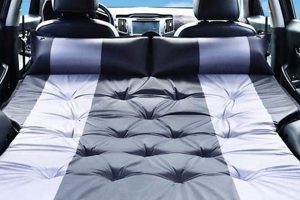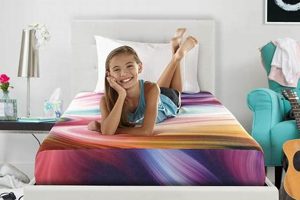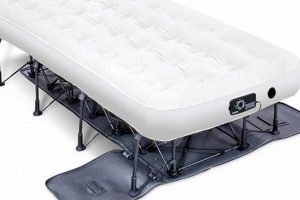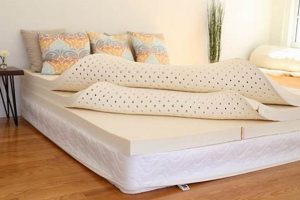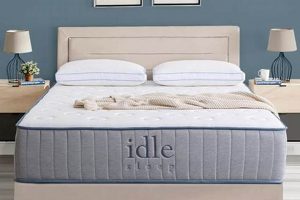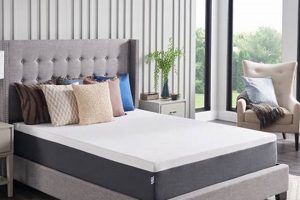A folding bed solution offering portability and convenience, often constructed from foam or a combination of foam and other materials, provides a compact sleeping surface. It is characterized by its ability to fold into three sections for simplified storage and transport. A quality model prioritizes comfort, durability, and ease of use, ensuring a suitable alternative to traditional mattresses in space-constrained environments or for temporary sleeping arrangements.
These adaptable sleeping solutions address the need for readily available and easily storable beds. Their folding design makes them ideal for apartments, dorm rooms, guest rooms, or camping trips. The benefits extend to cost-effectiveness, offering an affordable option compared to larger, stationary beds. Their historical context reflects evolving consumer needs for adaptable furniture driven by urbanization and smaller living spaces.
The subsequent sections will explore the key factors to consider when selecting a suitable folding mattress, including material composition, size variations, thickness options, comfort levels, and storage considerations. Further discussion will encompass the expected lifespan, maintenance requirements, and potential use cases across different environments.
Selection Guidance
The following guidelines aim to assist in making an informed decision when choosing a folding mattress, prioritizing long-term satisfaction and optimal use.
Tip 1: Material Evaluation: Prioritize foam density and composition. Higher density foams offer improved support and durability, extending the lifespan of the mattress and enhancing user comfort. Research certifications such as CertiPUR-US to ensure materials are free from harmful substances.
Tip 2: Thickness Assessment: Evaluate the available thickness options. Greater thickness often correlates with improved comfort, but consider the trade-off with storage space. A balance must be achieved between comfort and ease of storage.
Tip 3: Size Determination: Measure the intended usage area. Folding mattresses are available in various sizes, from twin to queen. Accurate measurements will ensure a proper fit and prevent unnecessary inconvenience.
Tip 4: Cover Examination: Inspect the mattress cover material and construction. Removable and washable covers provide enhanced hygiene and ease of maintenance. Opt for durable, stain-resistant fabrics for long-term use.
Tip 5: Storage Space Considerations: Analyze available storage space. Consider the folded dimensions of the mattress and ensure adequate room for storage when not in use. A compact, easily storable design is paramount.
Tip 6: Support requirements: if the mattress is placed directly on the floor you may need more support with a thicker option. If the mattress is going onto a platform the support requirements can be re-evaluated based on height of the platform.
Tip 7: Intended Use: evaluate if you are planning on daily or weekly use of the mattress. if you are planning on daily use, a higher quality option will be needed to ensure it stands up to the long term use.
Following these recommendations ensures a selection process that prioritizes comfort, durability, and practicality. Careful consideration of these factors contributes to a well-informed purchasing decision.
The succeeding sections will delve into specific product recommendations and comparisons, offering a detailed overview of leading options available in the market.
1. Comfort
Comfort is a paramount consideration when evaluating folding mattresses. The ability of a sleeping solution to provide adequate rest and relaxation directly impacts its usability and overall value. Several factors contribute to the subjective experience of comfort, each demanding careful assessment.
- Foam Density and Composition
The density of the foam core plays a significant role in pressure distribution and spinal alignment. Higher density foams, typically measured in pounds per cubic foot, offer greater resistance to compression and provide enhanced support. The composition, whether memory foam, polyurethane foam, or a combination, also influences the feel and responsiveness of the mattress. Memory foam conforms to the body’s contours, while polyurethane foam offers a more resilient surface. Inadequate foam density can result in sagging, discomfort, and potential back pain.
- Thickness and Layering
The overall thickness and layering of the mattress impact its ability to cushion pressure points. Thicker mattresses generally offer greater comfort, but this must be balanced with storage considerations. The layering of different foam types, such as a high-density base layer for support and a softer top layer for comfort, can optimize the sleeping experience. Insufficient thickness may lead to a feeling of sleeping directly on the floor or underlying surface.
- Cover Material and Construction
The material and construction of the mattress cover influence breathability and surface texture. Breathable fabrics, such as cotton or bamboo, help regulate temperature and prevent overheating. A smooth, non-abrasive surface enhances comfort by reducing friction against the skin. Poorly constructed covers can be prone to tearing, impacting the overall feel and durability of the mattress. The presence of hypoallergenic properties may also be a consideration for sensitive individuals.
- Support and Spinal Alignment
The mattress must provide adequate support to maintain proper spinal alignment during sleep. Insufficient support can lead to muscle strain and discomfort. The mattress should conform to the body’s natural curves, preventing pressure points from developing. A balanced level of firmness is necessary to provide both support and comfort, catering to individual sleeping preferences and body weight. The trifold mattress should provide the right amount of support.
These considerations underscore the multifaceted nature of comfort in the context of folding mattresses. A carefully selected model, incorporating appropriate foam density, thickness, cover material, and support characteristics, offers a more restful and enjoyable sleep experience. The ideal choice depends on individual preferences and specific needs, but a thorough assessment of these factors is essential for maximizing satisfaction with the investment.
2. Support
Adequate support is a fundamental characteristic of a high-quality folding mattress. The primary function of a mattress is to provide a stable and even surface that minimizes pressure points and maintains proper spinal alignment. Insufficient support leads to discomfort, potential back pain, and disrupted sleep. The relationship between support and a folding mattress is directly causal: a well-supported mattress promotes healthy sleep post
ure, while inadequate support can exacerbate existing musculoskeletal issues.
The composition and construction of the mattress core determine its level of support. High-density foam, for example, offers greater resistance to compression and distributes weight more evenly than lower-density alternatives. Consider individuals with varying body weights and sleeping positions. A lighter person might find adequate support in a medium-density foam, while a heavier individual requires a higher-density material to prevent sagging. Side sleepers need sufficient support to prevent their hips and shoulders from sinking too far into the mattress, maintaining spinal alignment. Similarly, back sleepers require support in the lumbar region to prevent lower back strain. The absence of proper support can manifest as a mattress that sinks unevenly over time, resulting in a hammock-like effect that compromises sleep quality.
In summary, support is a crucial element in a quality trifold mattress. Without adequate support, the mattress fails to fulfill its primary function of providing a comfortable and healthy sleeping surface. Understanding the connection between support and spinal alignment, foam density, and individual needs is essential for selecting a folding mattress that promotes restful sleep and minimizes potential health problems. The key challenge lies in assessing the support capabilities of a mattress before purchase, which can be mitigated through careful examination of product specifications, customer reviews, and, if possible, in-person testing. The consideration of support is key to determining what is in fact the “best trifold mattress.”
3. Portability
Portability is a defining characteristic of trifold mattresses, intrinsically linked to their utility and desirability. A primary purpose is to provide a readily transportable sleeping surface, facilitating usage in various locations. The folding design directly enables this portability, reducing the mattress’s footprint for easier handling and storage. A truly suitable trifold mattress prioritizes lightweight materials and a compact folded size, maximizing ease of transport. For example, an individual requiring a temporary bed for camping or accommodating guests in limited spaces necessitates a mattress that can be efficiently moved and stored. A heavier, bulkier model would negate these benefits, rendering it less practical for such applications.
The connection between portability and quality extends to the materials used. Lightweight, yet durable, foams and fabrics are crucial. A robust carrying case or integrated straps further enhance portability, safeguarding the mattress during transport and simplifying handling. In practical terms, this translates to a product that can be effortlessly relocated between rooms, transported in a vehicle, or stored in a closet without undue strain. The degree of portability directly influences the situations in which the mattress can be effectively employed, expanding its versatility and overall value. The presence of handles enhances a trifold mattresss portability.
In conclusion, portability is not merely an ancillary feature of a trifold mattress; it is a core attribute that defines its purpose and utility. Selecting a model that prioritizes lightweight construction, compact dimensions, and convenient carrying mechanisms is essential for realizing the full benefits of this type of sleeping solution. Overlooking this aspect compromises the very reason for choosing a trifold mattress over a more traditional, stationary alternative. Prioritizing portability determines if a trifold mattress can be called “best”.
4. Durability
The longevity and resilience of a trifold mattress are critical factors in determining its overall value and suitability for long-term use. Durability, in this context, signifies the ability of the mattress to withstand repeated use, folding, and storage without significant degradation in performance or structural integrity. The determination of a “best trifold mattress” hinges significantly on its inherent durability.
- Material Quality and Density
The quality and density of the foam or other core materials directly influence the mattress’s resistance to compression and wear. Higher density foams retain their shape and support properties longer than lower density alternatives. Inferior materials may break down prematurely, leading to sagging, uneven surfaces, and reduced comfort. The selection of appropriate materials is paramount for ensuring long-term durability.
- Construction and Stitching
The manner in which the mattress is constructed, including the quality of stitching and seams, contributes significantly to its structural integrity. Reinforced seams and durable stitching prevent tearing and separation of the mattress layers, particularly at the folding points. Weak or poorly executed construction can lead to premature failure, especially under frequent use or heavy loads.
- Cover Fabric and Resistance to Abrasion
The cover fabric protects the internal components of the mattress from dirt, moisture, and physical damage. Durable, abrasion-resistant fabrics withstand repeated friction from use and storage, preventing tears and wear. A robust cover also enhances the mattress’s resistance to staining and mildew growth, further extending its lifespan. A flimsy or easily damaged cover compromises the overall durability of the mattress.
- Resistance to Sagging and Deformation
A durable trifold mattress should maintain its shape and support characteristics over time, resisting sagging and deformation. Repeated folding and unfolding can stress the mattress’s internal structure, potentially leading to permanent indentations or uneven surfaces. Mattresses with robust construction and high-quality materials are better equipped to withstand these stresses, providing consistent support and comfort throughout their lifespan. A durable trifold mattress needs to retain its shape over time.
The assessment of durability is integral to identifying a “best trifold mattress.” A mattress that exhibits high-quality materials, robust construction, and resistance to wear and tear offers a superior long-term value proposition. Neglecting the durability aspect may result in a product that quickly deteriorates, requiring premature replacement and negating any initial cost savings. The long term resilience of the matress needs to be considered.
5. Size
Size is a critical determinant in the selection of a trifold mattress, directly impacting its usability and suitability for specific applications. The dimensions of the mattress, both unfolded and folded, must align with the intended use case to ensure optimal functionality. A misjudgment in size can render the mattress impractical, diminishing its value and overall effectiveness.
- Sleeping Area Dimensions
The unfolded dimensions dictate the available sleeping surface. Common sizes range from twin to queen, each catering to different occupancy needs. A larger sleeping area accommodates multiple individuals or provides added comfort for a single user. Conversely, a smaller size conserves space but may compromise sleeping comfort, particularly for ta
ller individuals or those who prefer ample room to move. The intended user and sleeping preferences must inform the selection of appropriate sleeping area dimensions. - Folded Dimensions and Storage Space
The folded dimensions determine the space required for storage when the mattress is not in use. Compact folded dimensions facilitate storage in closets, under beds, or in vehicles. Limited storage space necessitates careful consideration of the folded size. A larger, thicker mattress may offer superior comfort but requires more storage space, potentially posing a logistical challenge in smaller living environments. The relationship between comfort and storage must be carefully balanced.
- Weight Considerations
Mattress size influences its overall weight, affecting portability and ease of handling. Larger mattresses generally weigh more, making them more challenging to transport and maneuver. Frequent relocation necessitates a lighter mattress, even if it involves a trade-off in size or comfort. The user’s physical capabilities and the frequency of transport should guide the selection of an appropriate weight range.
- Compatibility with Frames or Platforms
The size of the mattress must be compatible with any intended frames or platforms. Standard mattress sizes correspond to standard frame dimensions, ensuring a proper fit. Non-standard sizes may require custom frames or platforms, adding to the overall cost and complexity. Verifying compatibility before purchase is essential to avoid usability issues. Ensuring size compatibility with your bed platform to be considered “best trifold mattress”.
These facets highlight the interconnectedness of size with the practical application of a trifold mattress. The optimal choice reflects a compromise between sleeping comfort, storage convenience, portability, and compatibility with existing infrastructure. Overlooking any of these size-related considerations can result in a suboptimal purchase that fails to meet the user’s specific needs. Selecting the ideal size is critical to maximize usability. The right size is a key component of selecting what constitutes a “best trifold mattress”.
6. Storage
The storage capabilities of a trifold mattress directly influence its practicality and overall suitability for various living situations. A key consideration in determining the mattress is its ability to be efficiently stored when not in use. Efficient storage is a defining characteristic, directly affecting user convenience and space optimization.
- Folded Dimensions and Space Optimization
The compacted dimensions of the mattress in its folded configuration dictate the ease with which it can be stored in closets, under beds, or in other limited spaces. Smaller folded dimensions allow for greater flexibility in storage options, making the mattress more adaptable to smaller living environments. A bulky, difficult-to-store mattress undermines the very purpose of selecting a folding model. The capacity to optimize space through efficient storage directly correlates with the practicality of the mattress in real-world scenarios.
- Weight and Ease of Handling
The weight of the mattress, while related to size, also impacts its ease of handling during storage. A lighter mattress is easier to lift and maneuver into storage spaces, reducing strain and increasing convenience. Heavier mattresses may require assistance or specialized equipment for storage, diminishing their practicality for individuals living alone or with physical limitations. The combination of compact folded dimensions and manageable weight enhances the overall storage experience.
- Protective Covers and Storage Conditions
The presence of a protective cover, whether integrated or purchased separately, safeguards the mattress during storage, preventing dust accumulation, moisture damage, and pest infestation. A durable, water-resistant cover maintains the cleanliness and integrity of the mattress, extending its lifespan and preserving its comfort. Proper storage conditions, such as a dry, well-ventilated environment, further contribute to the longevity of the mattress and prevent mold or mildew growth. An appropriate cover keeps a trifold mattress clean and dry while in storage.
- Carrying Mechanisms and Portability During Storage
Integrated carrying handles or straps facilitate the transport of the mattress to and from storage locations. These features enhance portability and reduce the effort required to move the mattress, particularly in situations where storage spaces are located at a distance or on different levels. A well-designed carrying mechanism simplifies the storage process and reduces the risk of damage to the mattress during handling. These mechanisms are a key component of a trifold mattress.
The ability to efficiently store a trifold mattress is a primary factor in determining its suitability and value. Compact folded dimensions, manageable weight, protective covers, and convenient carrying mechanisms collectively contribute to a positive storage experience, enhancing the overall practicality and desirability of the mattress. Prioritizing these storage-related aspects ensures that the mattress remains a convenient and space-saving sleeping solution, aligning with the core benefits of its design. The ease of storage is a key ingredient for a “best trifold mattress”.
Frequently Asked Questions About the Best Trifold Mattress
This section addresses common inquiries regarding the selection and use of trifold mattresses, providing informative answers to facilitate informed decision-making.
Question 1: What factors determine the comfort level of a trifold mattress?
Comfort is primarily influenced by foam density, thickness, and cover material. Higher density foams offer better support, while adequate thickness cushions pressure points. Breathable cover fabrics enhance temperature regulation. Consider the quality of the foam to determine what is the “best trifold mattress”.
Question 2: How does one assess the durability of a trifold mattress before purchase?
Examine material specifications, focusing on foam density and fabric composition. Check for reinforced seams and durable stitching. Customer reviews can provide insights into real-world performance and longevity.
Question 3: What size trifold mattress is most suitable for limited storage space?
Measure the available storage area to determine maximum allowable folded dimensions. Smaller twin-size mattresses generally offer the most compact storage footprint, but may compromise sleeping area.
Question 4: Can a trifold mattress be used as a primary sleeping surface?
While trifold mattresses are primarily designed for temporary use, higher-quality models with adequate support and thickness can serve as acceptable primary sleeping surfaces for certain individuals, especially those with space constraints.
Question 5: What is the proper method for cleaning and maintaining a trifold mattress?
Follow the manufacturer’s instructions for cleaning. Regularly vacuum the surface to remove dust and debris. Spot clean stains with mild detergent and water. Allow the mattress to air dry thoroughly before storing. A removable and washable cover makes maintenance easier.
Question 6: Are there any specific certifications to look for when purchasing a trifold mattress?
Certifications such as CertiP
UR-US ensure that the foam used in the mattress is free from harmful chemicals and meets certain performance standards. Look for this certification to verify the safety and quality of the product.
In summary, informed decision-making regarding trifold mattresses involves careful consideration of comfort, durability, size, intended use, maintenance, and certifications. A thorough understanding of these factors will aid in selecting a suitable and satisfactory product.
The following section will provide a comparative analysis of popular trifold mattresses currently available on the market.
Conclusion
This exposition has systematically dissected the attributes defining a superior folding mattress. Primary considerations include material composition, size adaptability, structural robustness, and storage efficiency. Each of these elements contributes to the overall performance and suitability of the product for diverse applications. The convergence of these factors ultimately determines the value proposition presented by any specific folding mattress offering.
Ultimately, the selection of a “best trifold mattress” necessitates a careful evaluation of individual requirements and priorities. A thorough understanding of the factors discussed herein empowers consumers to make informed decisions, ensuring a purchase that aligns with their specific needs and delivers long-term satisfaction. Continued advancements in materials and design promise further refinements in folding mattress technology, offering enhanced comfort and convenience in the future.


